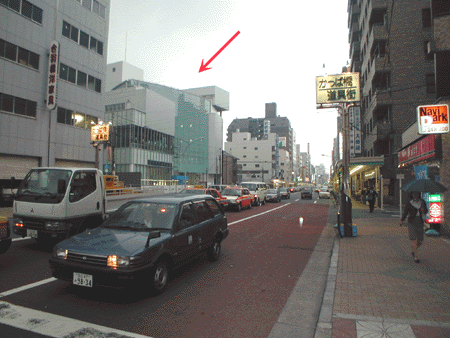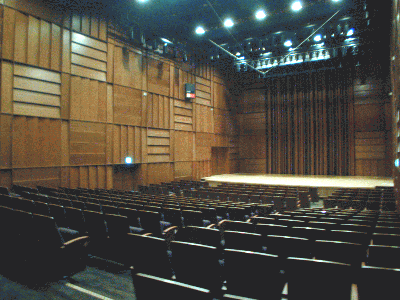
Title means "Quietness", "Comfortable Sound" and "Excellent Acoustics"
Nagata Acoustics News 02-1 (No.169)
Issued : January 25, 2002
Taito Ward Lifelong Learning Center
by Akira Ono
Lifelong Learning Center and
its neighborhood
 |
Taito Ward Lifelong Learning Center, which began construction in 1998 opened its doors for the first time in September 2001, in the Asakusa section of Tokyo's downtown Taito Ward. The project architect was Institute Of New Architecture.
<< The Center's Unique Neighborhood >>
The exact neighborhood of the new Lifelong Learning Center is named Kappa-bashi, a distinctive group of streets lined with shops that sell tools, decor, appliances and other merchandise for Japan's huge restaurant trade. In Kappa-bashi's shops restaurant owners, bartenders, professional chefs and tourists alike can find everything from commercial heating and refrigeration equipment to glass refrigeration cases for sushi bars, tables and chairs for coffee shops, pubs and restaurants, red lanterns and rope "noren" curtains to decorate the entrances of drinking establishments, cooking utensils and knives, woks and clay pots, and especially the now world-famous wax sculpture "samples" of every food dish imaginable. (In addition to written menus, Japanese restaurants often place three-dimensional wax replicas of their offerings in their windows as visual advertisements to potential patrons.) Most Kappa-bashi shops have signs stating that they cater to wholesale and business-to-business commerce, but they will also sell their merchandise to the many tourists from overseas who come in search of unique, culinary-related souvenirs.
<< The Center's Glass Facade and Chic Exterior Design >>
The new Lifelong Learning Center has six floors above ground and one basement level. Its exterior facade is a graceful, curved, glass surface that gives the building a sunny and refined feeling. Inside the entrance, an atrium rises the full six-stories high to the center's top floor, creating an open and unconfined atmosphere.
<< Components of a Lifelong Learning Center's Facilities >>
This lifelong learning center houses Taito Ward's main public library and a small concert hall named "Millennium Hall," four music practice rooms and two sound studios. It is also home to the Shotaro Ikenami Memorial Book Collection and an alternative educational space for children who cannot keep pace with the high-pressure environment of standard Japanese schools.
<< The Center's Sound Isolation Strategy >>
In this kind of building, it is especially important that certain rooms, such as the concert hall, music practice rooms and sound studios are well isolated from sound penetration by sound being generated in other rooms. Likewise, since it is likely that large volume sound may be produced in some of the rooms, the sounds in these rooms must be contained within the rooms and not allowed to adversely impact the usability of other rooms. Therefore, for multiuse buildings such as the Lifelong Learning Center, the sound isolation strategy is a major focus of our acoustical design work, with our aim being to eliminate any disturbances between and among the rooms when they are used simultaneously.
<< Careful Elimination of Crevices and Gaps During Construction >>
The Lifelong Learning Center was built using a steel-frame structure and fabricated using pre-cast panels rather than poured concrete. The basic wall divisions within the building are also pre-cast panels or extrusion-molded cement, not concrete. In order to achieve high performance sound isolation levels with this construction method, we repeatedly performed detailed inspections and applied corrective measures to eliminate the crevices and gaps that inevitably appear throughout structures of this kind.
<< Additional Sound Isolation Elements >>
We took additional sound isolation precautions in designing the concert hall, two sound studios and three of the music practice rooms by giving them concrete and elastic anti-vibration flooring, and by using multi-layer board panels in their interior wall construction. In the music practice rooms, we used a double layer of 60 mm. (2.4 in.) extrusion-molded cement panels as a fixed sound-isolation foundation layer, and in each room we added three layers of 21 mm. (0.8 in.) gypsum board for anti-vibration and sound isolation purposes.
<< Sound Isolation Strategy Results >>
As a result of our efforts and design strategy, we achieved a sound isolation level greater than D-80 (85 dB / at 500 Hz and above) between each of the music-related rooms and we achieved a sound isolation level greater than D-70 (75 dB / at 500 Hz and above) between each room and its adjacent corridor. Because a critical success factor for our sound isolation strategy was the quality and precision of its implementation during construction, we measured the sound isolation performance of the double-layer, 60 mm. (2.4 in.) extrusion-molded cement panels immediately after they were put in place on site. We thereby confirmed the success of our strategy at every stage of construction and the project proceeded from phase to phase after taking field measurements of the anti-vibration and sound isolation performance levels achieved.
<< Acoustical Design of Millennium Hall >>
Millennium Hall
 |
Millennium Hall is a 300-seat shoebox-configuration classical music concert hall. It is designed without a free span, and has an 11 m. (36 ft) high ceiling and a 12 m. (39 ft) width. The walls of the hall's interior are wood paneling stained to a rich, dark color that imparts a mature, serene atmosphere.
In a multipurpose facility such as a Lifelong Learning Center, the rectangular shape of a shoebox configuration hall makes it a desirable and convenient choice because it can be easily included among other rooms in the facility's floor plans. However, in the case of Millennium Hall, the requirements provided by local residents specified a hall for classical music of approximately 300 seats that would be easy for performers to use and would have excellent acoustical characteristics. We decided to recommend and implement the shoebox configuration because it best met the client's acoustical requirements, not because a rectangular shape is easy to fit into a multipurpose facility.
The 300-seat size of the concert hall makes it user-friendly for children's rehearsals and recitals and concerts by semi-professional and amateur musicians, creating a venue that fosters grass-roots cultural endeavors. Millennium hall's reverberation time is 1.7 seconds unoccupied, and 1.4 seconds when fully occupied (measured at 500 Hz).
<< The Mission of Japan's Lifelong Learning Centers >>
Numerous lifelong learning centers have been built throughout Japan. The origin of this recent burst of construction is the educational reform blueprint for the 21st century drafted by the Japanese national government. The goal of the educational reform initiative is to nurture an intellectually energetic and creative Japanese society, and the fundamental concept of the blueprint is to shift the nation from a reliance on formal academic schooling to a pattern of lifelong learning opportunities.
Implementation of the educational reforms fell to Japan's Education and Science Ministry. (At the time that the reform blueprint was announced, this ministry's portfolio was solely Education, but Japan has now restructured the responsibilities of this government ministry.) The Education and Science Ministry established a Bureau of Lifelong Learning and drafted a Lifelong Learning Law for the Diet's approval. In 2001, the ministry strengthened the ability of the Bureau of Lifelong Learning to turn policy into action and it gave the bureau the new name of Lifelong Learning Production Bureau.
One reform objective set by the Education and Science Ministry aims to relieve the high-pressure environment that pervades Japan's K-to-12 schools by changing the normal school schedule from a six-day-week schedule to a five-day-week schedule. In addition, the ministry put forth curriculum changes and programs to give more responsibility and opportunity for communities and parents to play an active role in educating the nation's youth. In this context, local communities have promoted the building of lifelong learning centers as a means of jumpstarting their greater involvement in the educational lives of the nation's children.
As in other post-industrial nations, Japan faces some disturbing trends in its school-age population, including problems of student peer-bullying and an increased rate of juvenile crimes. In particular, the troubled Japanese child often acts out his or her problems by refusing to attend school at all. The nation believes that individual families and regional communities must play a significant role in redressing these trends. Communities that build lifelong learning centers do so with the hope that the facility will somehow be an answer to the need for new approaches to raising and mentoring new generations.
However, for the lifelong learning centers to have an impact on the lives of Japan's children, what is truly important is not the concrete buildings we build, but the establishment of a diverse and effective range of programs and activities that meet the many varied needs of today's students. "Lifelong learning" is the sophisticated concept of academics who envision each individual having the self-direction to discover and pursue means to intellectual and educational growth that suit his or her interests and talents. However, in my opinion, for a troubled child who suddenly refuses to leave home each morning to go school, what is most needed is for Japan's K-to-12 academic institutions to increase their levels of interaction and creative intervention and to utilize the full capabilities of the formal educational setting to instruct and guide each child so that no child "falls through the cracks."
<< Space for Troubled Children at Taito Ward Lifelong Learning Center >>
Appropriately, the Taito Ward Lifelong Learning Center devotes its sixth floor to a school for primary and middle school age children who refuse to attend school. The center also offers child-counseling services. I wish these efforts much success and hope that they will become a model for other communities to take action.
E-mail Distribution of Nagata Acoustics News & Opinions
We hope you have enjoyed this News & Opinions newsletter, available each month on our web-site (http://www.nagata.co.jp). We also offer e-mail delivery of the text version of this newsletter. To receive the text newsletter to your e-mail address, simply send the following information to us at "newsmail_e@nagata.co.jp"
(1) Your e-mail address
(2) Your name
(3) The name of your company
By requesting the text version via e-mail, you will automatically receive every newsletter and you can still get the visuals and graphics at our web-site.
Nagata Acoustics News 02-1(No.169)
Issued : January 25, 2002
Nagata Acoustics Inc.
Hongo Segawa Bldg. 3F, 2-35-10
Hongo, Bunkyo-ku, Tokyo 113-0033 Japan
Tel: +81-3-5800-2671, Fax: +81-3-5800-2672
E-mail: info@nagata.co.jp




